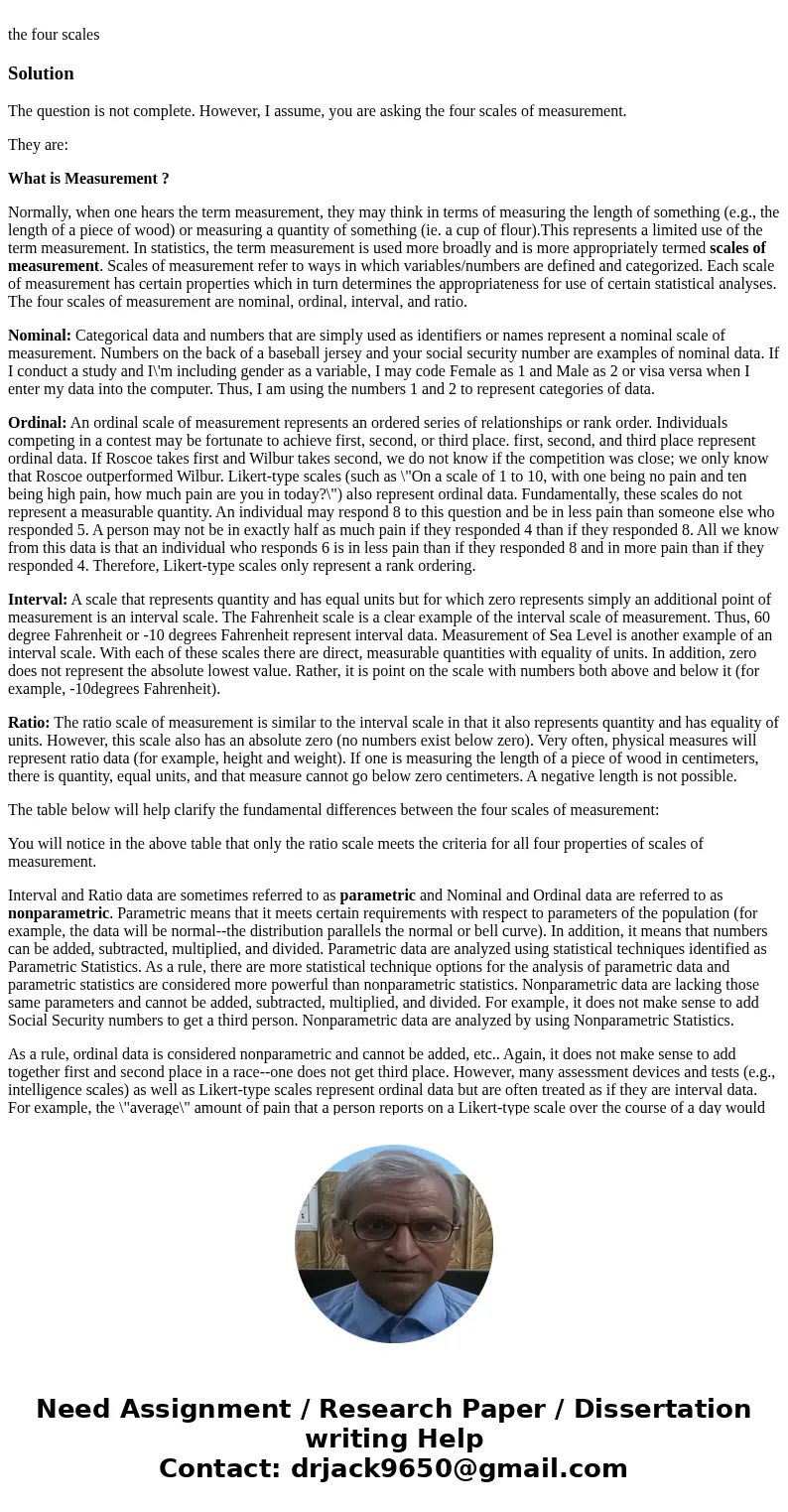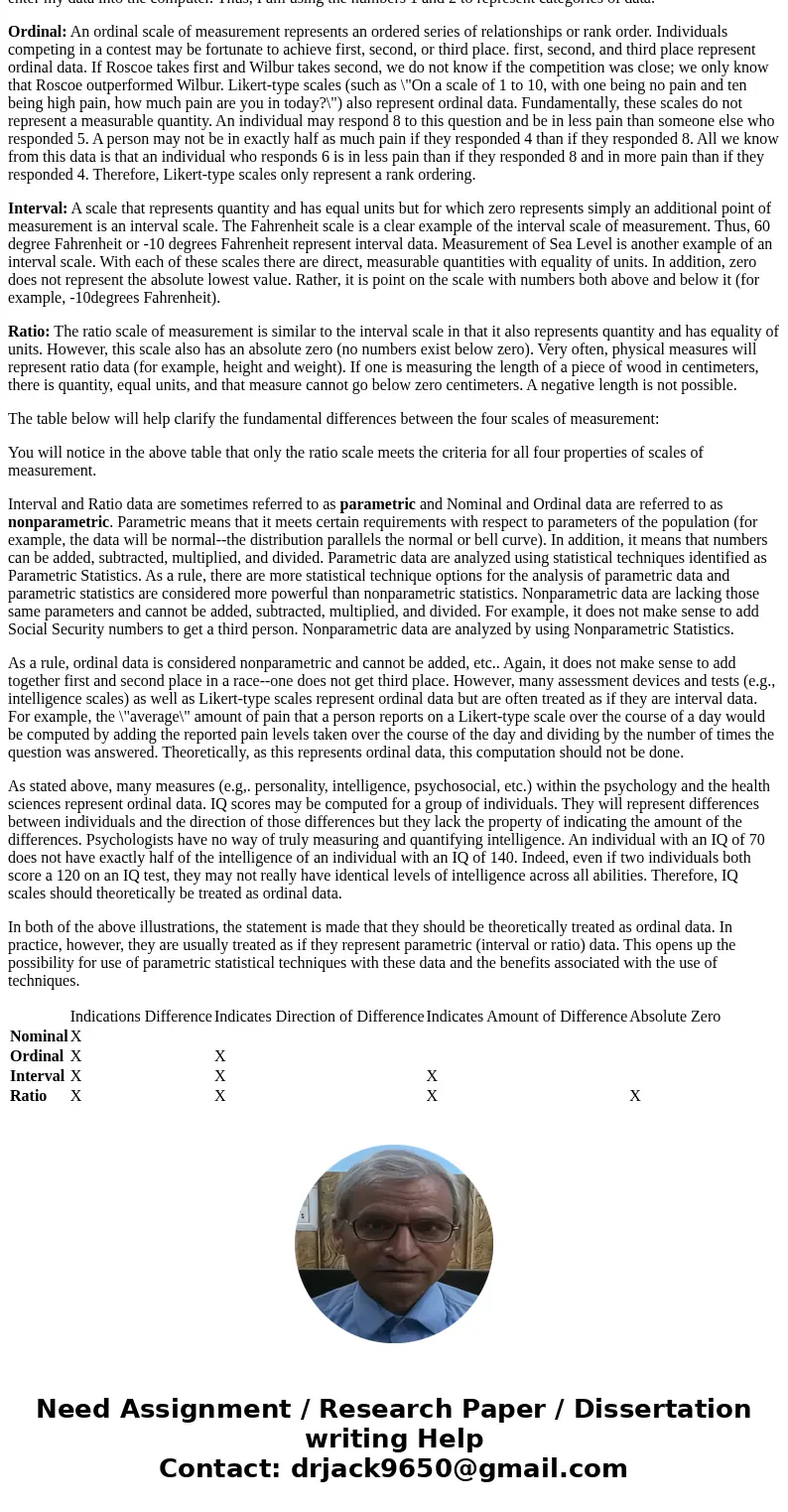the four scalesSolutionThe question is not complete However
the four scales
Solution
The question is not complete. However, I assume, you are asking the four scales of measurement.
They are:
What is Measurement ?
Normally, when one hears the term measurement, they may think in terms of measuring the length of something (e.g., the length of a piece of wood) or measuring a quantity of something (ie. a cup of flour).This represents a limited use of the term measurement. In statistics, the term measurement is used more broadly and is more appropriately termed scales of measurement. Scales of measurement refer to ways in which variables/numbers are defined and categorized. Each scale of measurement has certain properties which in turn determines the appropriateness for use of certain statistical analyses. The four scales of measurement are nominal, ordinal, interval, and ratio.
Nominal: Categorical data and numbers that are simply used as identifiers or names represent a nominal scale of measurement. Numbers on the back of a baseball jersey and your social security number are examples of nominal data. If I conduct a study and I\'m including gender as a variable, I may code Female as 1 and Male as 2 or visa versa when I enter my data into the computer. Thus, I am using the numbers 1 and 2 to represent categories of data.
Ordinal: An ordinal scale of measurement represents an ordered series of relationships or rank order. Individuals competing in a contest may be fortunate to achieve first, second, or third place. first, second, and third place represent ordinal data. If Roscoe takes first and Wilbur takes second, we do not know if the competition was close; we only know that Roscoe outperformed Wilbur. Likert-type scales (such as \"On a scale of 1 to 10, with one being no pain and ten being high pain, how much pain are you in today?\") also represent ordinal data. Fundamentally, these scales do not represent a measurable quantity. An individual may respond 8 to this question and be in less pain than someone else who responded 5. A person may not be in exactly half as much pain if they responded 4 than if they responded 8. All we know from this data is that an individual who responds 6 is in less pain than if they responded 8 and in more pain than if they responded 4. Therefore, Likert-type scales only represent a rank ordering.
Interval: A scale that represents quantity and has equal units but for which zero represents simply an additional point of measurement is an interval scale. The Fahrenheit scale is a clear example of the interval scale of measurement. Thus, 60 degree Fahrenheit or -10 degrees Fahrenheit represent interval data. Measurement of Sea Level is another example of an interval scale. With each of these scales there are direct, measurable quantities with equality of units. In addition, zero does not represent the absolute lowest value. Rather, it is point on the scale with numbers both above and below it (for example, -10degrees Fahrenheit).
Ratio: The ratio scale of measurement is similar to the interval scale in that it also represents quantity and has equality of units. However, this scale also has an absolute zero (no numbers exist below zero). Very often, physical measures will represent ratio data (for example, height and weight). If one is measuring the length of a piece of wood in centimeters, there is quantity, equal units, and that measure cannot go below zero centimeters. A negative length is not possible.
The table below will help clarify the fundamental differences between the four scales of measurement:
You will notice in the above table that only the ratio scale meets the criteria for all four properties of scales of measurement.
Interval and Ratio data are sometimes referred to as parametric and Nominal and Ordinal data are referred to as nonparametric. Parametric means that it meets certain requirements with respect to parameters of the population (for example, the data will be normal--the distribution parallels the normal or bell curve). In addition, it means that numbers can be added, subtracted, multiplied, and divided. Parametric data are analyzed using statistical techniques identified as Parametric Statistics. As a rule, there are more statistical technique options for the analysis of parametric data and parametric statistics are considered more powerful than nonparametric statistics. Nonparametric data are lacking those same parameters and cannot be added, subtracted, multiplied, and divided. For example, it does not make sense to add Social Security numbers to get a third person. Nonparametric data are analyzed by using Nonparametric Statistics.
As a rule, ordinal data is considered nonparametric and cannot be added, etc.. Again, it does not make sense to add together first and second place in a race--one does not get third place. However, many assessment devices and tests (e.g., intelligence scales) as well as Likert-type scales represent ordinal data but are often treated as if they are interval data. For example, the \"average\" amount of pain that a person reports on a Likert-type scale over the course of a day would be computed by adding the reported pain levels taken over the course of the day and dividing by the number of times the question was answered. Theoretically, as this represents ordinal data, this computation should not be done.
As stated above, many measures (e.g,. personality, intelligence, psychosocial, etc.) within the psychology and the health sciences represent ordinal data. IQ scores may be computed for a group of individuals. They will represent differences between individuals and the direction of those differences but they lack the property of indicating the amount of the differences. Psychologists have no way of truly measuring and quantifying intelligence. An individual with an IQ of 70 does not have exactly half of the intelligence of an individual with an IQ of 140. Indeed, even if two individuals both score a 120 on an IQ test, they may not really have identical levels of intelligence across all abilities. Therefore, IQ scales should theoretically be treated as ordinal data.
In both of the above illustrations, the statement is made that they should be theoretically treated as ordinal data. In practice, however, they are usually treated as if they represent parametric (interval or ratio) data. This opens up the possibility for use of parametric statistical techniques with these data and the benefits associated with the use of techniques.
| Indications Difference | Indicates Direction of Difference | Indicates Amount of Difference | Absolute Zero | |
| Nominal | X | |||
| Ordinal | X | X | ||
| Interval | X | X | X | |
| Ratio | X | X | X | X |


 Homework Sourse
Homework Sourse